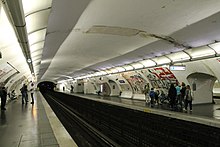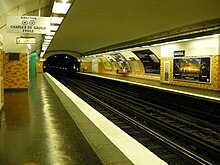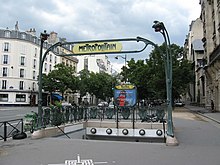Raspail (Métro Paris)
|
|
|
|---|---|

|
|
| Tariff zone | 1 |
| Line (s) |
|
| place | Paris XIV |
| opening | April 24, 1906 |
Raspail is an underground transfer station for lines 4 and 6 of the Paris Métro .
location
The metro station is located in the Quartier du Montparnasse in the 14th arrondissement of Paris . The stations of the two lines are located next to each other under Boulevard Raspail south of the confluence of Boulevard Edgar Quinet.
Surname
It is named after the Boulevard Raspail. The chemist François-Vincent Raspail (1794–1878) participated in the 1848 Constituent Assembly. As an advocate of universal suffrage, he had to emigrate to Belgium in 1849, where he lived in exile until 1863. On his return he was a member of the Bouches-du-Rhône department in the National Assembly from 1876 until his death .
history
The station of today's line 6 went into operation on April 24, 1906, when the then section of line 2 Sud from Passy to Place d'Italie was opened. On October 14, 1907, the previously independent line 2 Sud was given up and moved to the southwestern end of line 5 ( Étoile - Gare du Nord ). Line 6 has been operating at the station since October 6, 1942, and in July 1974 this line was rebuilt for use with pneumatic trains .
The station on line 4 was opened on October 30, 1909. The line initially consisted of two spatially separated parts, a northern section opened in 1908 and a section south of the Seine . The latter ran from Porte d'Orléans to Raspail station, which was the northern end of the line until January 9, 1910. That day, the extension to Châtelet , which connected the two sections , went into operation.
In 2008 the subway station was renovated and got its original white decor back instead of the orange wall tiles that had existed for decades.
description
The two stations are located parallel to each other on the same level. They are separated from each other by a retaining wall pierced in several places, the openings allow direct changes between the platforms to the south of line 4 and to the north-west of line 6.
The cross-section of the stations describes an ellipse , the curvature of which is followed by the side walls. The height at the apex of the vaulted ceiling is 5 m above the top of the rails, the side platforms are 4 m wide. When it opened, it was 75 m long. In the mid-1960s, the station on Line 4 was extended to 90 m and adapted for use with pneumatic trains. To the south of its station, line 6 has a simple track change .
There are two entrances at the junction of Boulevard Edgar Quinet and Rue Campagne Premiere. The western one has the Art Nouveau décor designed by Hector Guimard , the eastern one is marked by a yellow “M” in a double circle. Another entrance at the southern end of the station is reserved for staff.
vehicles
Until 1928, 5-car trains consisting of initially three twin-engine and later two four-engine railcars and sidecars ran on Line 4 . They were replaced by Sprague-Thomson trains , which were successively replaced by rubber-tired 6-car trains of the MP 59 series in 1966/67 . The MP 89 CC series is currently in use on Line 4 .
Today's line 6 was used by Sprague-Thomson trains from around 1910. In July 1974 the line was switched to vehicles with rubber tires, and the MP 73 series has been operating there ever since .
Surroundings
- The Cimetière Montparnasse Cemetery , where Charles Baudelaire , Jean-Paul Sartre and Samuel Beckett , among others , were buried, is in the immediate vicinity
- Fondation Cartier pour l'Art Contemporain , museum of contemporary art
- School of Architecture École Spéciale d'Architecture
Remarks
- ↑ First of all, all stations were tiled in white, as the then sparse light from the station lighting was reflected more strongly
- ↑ CC means "Conduite Conducteur" (driver-controlled), in contrast to the driverless type MP 89 CA
Web links
literature
- Gérard Roland: Stations de métro. D'Abbesses à Wagram . 2003, ISBN 2-86253-307-6 .
Individual evidence
- ^ Gérard Roland: Stations de métro d'Abbesses à Wagram . Christine Bonneton, Clermont-Ferrand 2011, ISBN 978-2-86253-382-7 , pp. 182 .
- ^ Jean Tricoire: Un siècle de métro en 14 lignes. De Bienvenüe à Météor . 2nd Edition. La Vie du Rail, Paris 2000, ISBN 2-902808-87-9 , p. 210 .
- ↑ Jean Tricoire: op. Cit. P. 183.
- ↑ Jean Tricoire: op. Cit. P. 43.
- ^ Brian Hardy: Paris Metro Handbook . 3. Edition. Capital Transport Publishing, Harrow Weald 1999, ISBN 1-85414-212-7 , pp. 36 .
- ↑ Jean Tricoire: op. Cit. P. 183 f.
- ↑ Jean Tricoire: op. Cit. P. 219 f.
| Previous station | Paris metro | Next station |
|---|---|---|
|
Vavin ← Porte de Clignancourt |
|
Denfert-Rochereau Mairie de Montrouge → |
|
Edgar Quinet ← Charles de Gaulle - Étoile |
|
Denfert-Rochereau Nation → |
Coordinates: 48 ° 50 ′ 20.6 " N , 2 ° 19 ′ 50.4" E




